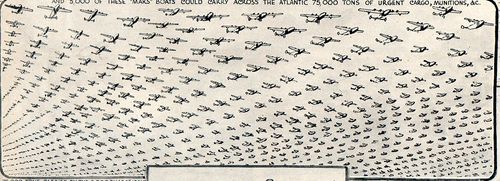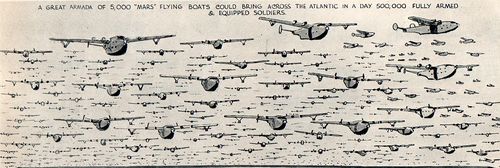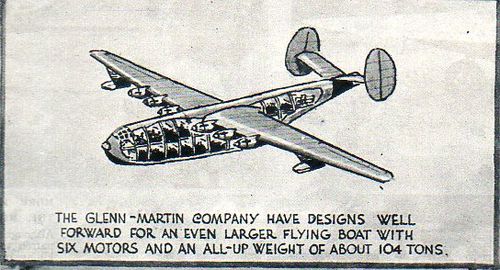JF Ptak Science Bools Quick Post
This post continues an earlier series on the artistic display of quantitative data--putting a face on big numbers. In particular it extends a collection of images of Second World War airplanes, "A Big Sea of Planes: Quantitative Display of World War II Bombers. The images below appear in the 17 October 1942 issue of the Illustrated London News in an article about the possibility of replacing seaborne troop and materiel transport across the Atlantic from America with the big Martin JRM Mars aircraft, getting the troops there faster and safer and releasing at least part of the naval force for wartime activities. The images are pretty compelling:
The caption states that 5000 Mars planes could get 500,000 soldiers to Europe.
These were big planes1 (200' wingspan, 117' long, 38' high, more below) and could haul 130+ troops. By the time though that the powers-that-be were figuring out who the main contractor would be for production (and those production numbers in early 1942 were about 500 per year, at that point, anyway) the Battle of the Atlantic was already--in 1943--fairly well decided. The U-Boot problem was solved enough for a continuous flow of soldiers and supplies, though not without a high cost in the first half of the Atlantic campaign. (Overall, from 1939 to 1945, some 3,500 Allied merchant ships and 175 Allied warships were sunk, costing the lives of 72,200 Allied sailors and merchant seamen. The Germans lost more than 780 submarines along with fully three-quarters of all sailors in the U-Boot fleet, making some 30,000 men.)
Below, a cutaway for the Mars:
Stats and Technical data on the Glenn-Martin(from Jane’s Fighting Aircraft of World War II, (1945):
Crew: four (with accommodations for a second relief crew
Capacity: 133 troops, or 84 litter patients and 25 attendants
Payload: 32,000 lb (15,000 kg) of cargo, including up to seven jeeps
Length: 117 ft 3 in (35.74 m)
Wingspan: 200 ft 0 in (60.96 m)
Height: 38 ft 5 in (11.71 m)
Wing area: 3,686 ft² (342.4 m²)
Empty weight: 75,573 lb (34,279 kg)
Loaded weight: 90,000 lb (40,820 kg)
Max takeoff weight: 165,000 lb (74,800 kg)
Powerplant: 4 × Wright R-3350-24WA Duplex Cyclone 18-cylinder radial engines, 2,500 hp (1,900 kW) each
Performance
Maximum speed: 192 knots (221 mph, 356 km/h)
Cruise speed: 165 knots (190 mph, 305 km/h)
Range: 4,300 nautical miles (5,000 mi, 8,000 km)
Service ceiling: 14,600 ft (4,450 m)






Comments